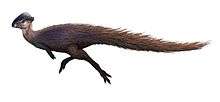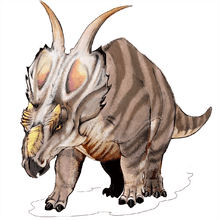Mojoceratops
| Mojoceratops Temporal range: Late Cretaceous, 76.5–75 Ma | |
|---|---|
 | |
| Skeletal restoration | |
| Scientific classification | |
| Kingdom: | Animalia |
| Phylum: | Chordata |
| Class: | Reptilia |
| Clade: | Dinosauria |
| Order: | †Ornithischia |
| Family: | †Ceratopsidae |
| Subfamily: | †Chasmosaurinae |
| Genus: | †Mojoceratops Longrich, 2010 |
| Species: | †M. perifania |
| Binomial name | |
| Mojoceratops perifania Longrich, 2010 | |
Mojoceratops is a genus of ceratopsian dinosaur. It is a chasmosaurine ceratopsid which lived during the Late Cretaceous period, in what is now Western Canada. The genus is based on skulls first assigned to species of the contemporary ceratopsid Chasmosaurus. First given a unique name in 2010, later research has suggested that Mojoceratops is a synonym of Chasmosaurus as originally thought.
Discovery
The species Mojoceratops perifania was based on holotype specimen TMP 1983.25.1 consisting of a partial skull including the parietal and from the paratypes TMP 1999.55.292, an isolated lateral ramus of a right parietal, and NMC 8803, central bar and lateral rami of parietals. Specimens AMNH 5656, NMC 34832 and TMP 1979.11.147, and (tentatively) AMNH 5401 and NMC 1254 were also referred to the genus. All specimens assigned to Mojoceratops were collected from the Dinosaur Park Formation (late Campanian, 76.5–75 ma) of the Belly River Group of Alberta and Saskatchewan, western Canada. Mojoceratops was first named by Nicholas R. Longrich in 2010 and the type species is Mojoceratops perifania. The generic name is derived from mojo and the specific name means "conspicuous pride" in Greek, both referring to the skull frill. The species is based on fossils thought by other researchers to belong to Chasmosaurus.[1]
Classification

The species Chasmosaurus kaiseni, known from specimen AMNH 5401, a nearly complete (but partially restored) skull on display at the American Museum of Natural History, was considered to share features in common with Mojoceratops perifania and therefore was considered a possible synonym. However, the parietal (back margin of the frill) is not preserved, and was restored in plaster based on other Chasmosaurus specimens, which caused confusion among scientists in previous decades. Because the parietal bone is critical for determining differences between species in ceratopsids like Chasmosaurus and Mojoceratops, C. kaiseni was by Longrich regarded as a nomen dubium, rather than as the senior synonym of M. perifania. Longrich also regarded the holotype of Eoceratops as probably being an exemplar of Mojoceratops. He considered it too poorly preserved for a reliable determination, especially as it belonged to a juvenile individual, and regarded it too as a nomen dubium, rather than as the senior synonym of M. perifania.[1] A 2016 overview of Chasmosaurus found C. kaiseni and Eoceratops to be referable to Chasmosaurus sp. due to the lack of the parietal preserved in the holotypes of both.[2]
Following the original assignment of the holotype and other skulls to Mojoceratops, several teams of researchers published work questioning the validity of this new genus. In 2011, Maidment & Barrett failed to confirm the presence of any supposedly unique features, and argued that Mojoceratops perifania was a synonym of Chasmosaurus russelli. Campbell and colleagues, in their 2016 analysis of Chasmosaurus specimens, agreed with the conclusions of Maidment & Barrett, adding that some supposedly unique features, such as grooves on the parietal bone, were actually also present in the holotype of C. russelli and, to various degrees, in other Chasmosaurus specimens. This variability, they argued, strongly suggested that Mojoceratops was simply a mature growth stage of C. russelli.[2]
See also
References
- 1 2 Nicholas R. Longrich (2010). "Mojoceratops perifania, A New Chasmosaurine Ceratopsid from the Late Campanian of Western Canada". Journal of Paleontology. 84 (4): 681–694. doi:10.1666/09-114.1.
- 1 2 Campbell, J.A., Ryan, M.J., Holmes, R.B., and Schröder-Adams, C.J. (2016). A Re-Evaluation of the chasmosaurine ceratopsid genus Chasmosaurus (Dinosauria: Ornithischia) from the Upper Cretaceous (Campanian) Dinosaur Park Formation of Western Canada. PLoS ONE, 11(1): e0145805. doi:10.1371/journal.pone.0145805


